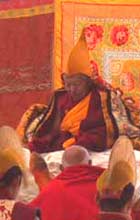
There are health risks to traveling to high altitude. Travelers should consult their physicians for more information..
Day One
Lhasa's altitude is about 3,650 meters or 12,000 feet, so we will enjoy a relaxed itinerary over the first days so as to acclimatize to the thinner air. (Sheraton Four Points Hotel) (D)
Day Two
The "land of the snows" has inspired artists for centuries. James Hilton's utopianist "Shangrila" is based on Tibet's monastic communities and devout way of life. To best appreciate Lhasa's palaces, temples and society, we have arranged for a morning lecture to familiarize you with the main themes, characters and symbols of Tibetan art and religious life.
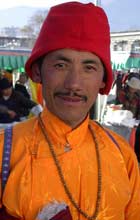 You will be able to apply this knowledge after lunch when we head to the center of Lhasa's religious life at its Jokhang Monastery . It is impossible to put into words the sense of peace and equanimity that imbues the atmosphere of this historic monastery. On the one hand, Tibetan pilgrims display intense devotion as they prey before their deities, pouring yak (a local variety of cow) butter or ghee into the altars' butter lamps. On the other hand, the casual comings and goings of the red-robed monks lend this beautiful building the reliability of tradition and the self-confidence of knowledge. Afterwards, you will stroll onto the Barkhor for the first time. This is the kora , or pilgrimage route around the Jokhang Temple's circumference. As you amble along it, surrounded by pilgrims, you will be assailed by novel sights, sounds and wonders. Poking your nose into local Tibetan markets, your eyes will feast on strangely clad clansmen from Tibet's outlying regions and peruse the wares of the many antique and thangka shops of this astonishing circuit. After a late afternoon rest, we will return here in the evening to watch a Buddhist ceremony in a nearby temple. (B, L, D)
You will be able to apply this knowledge after lunch when we head to the center of Lhasa's religious life at its Jokhang Monastery . It is impossible to put into words the sense of peace and equanimity that imbues the atmosphere of this historic monastery. On the one hand, Tibetan pilgrims display intense devotion as they prey before their deities, pouring yak (a local variety of cow) butter or ghee into the altars' butter lamps. On the other hand, the casual comings and goings of the red-robed monks lend this beautiful building the reliability of tradition and the self-confidence of knowledge. Afterwards, you will stroll onto the Barkhor for the first time. This is the kora , or pilgrimage route around the Jokhang Temple's circumference. As you amble along it, surrounded by pilgrims, you will be assailed by novel sights, sounds and wonders. Poking your nose into local Tibetan markets, your eyes will feast on strangely clad clansmen from Tibet's outlying regions and peruse the wares of the many antique and thangka shops of this astonishing circuit. After a late afternoon rest, we will return here in the evening to watch a Buddhist ceremony in a nearby temple. (B, L, D)
Day Three
Since yesterday should have provided you with some of the most striking visual images of your life, the bar is set high for this morning's visit to the Potala Palace – the trapezoidal, red and white Winter Palace that oversees the growing city beneath. Few buildings are as emblematic of their nation expressing the remoteness and religious might of Tibet. The elaborate golden tombs of past Dalai Lamas are of inestimable beauty, value and mystery.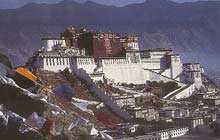
In the afternoon, we return to the center of Lhasa's old town, to the colorful and fascinating Barkhor. We will tour in more detail the incense burners, markers, temples and monasteries that punctuate this sacred pathway and spend more time soaking up the inimitable atmosphere of Lhasa's old quarter. In the evening, we will take in the flavor of Tibetan traditional arts in the form of a musical concert. (B, L, D)
Day Four
This morning we drive to Lhasa's outskirts to visit the grandiose Drepung monastery , at its height the largest monastery in the world with 10,000 monks in residence. Like Oxford and Cambridge Universities in England, also originally monasteries, Drepung Monastery adopted a collegiate system in which to organize its students. Each of the four colleges has a different focus and was famed for a separate area of research. The influential monastic authorities, who had overarching responsibility for the colleges, became an intellectual center of political as well as religious power in Tibet. Two Dalai Lamas are entombed here.
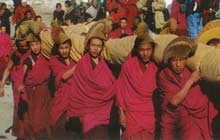 After lunch we will visit a craft studio responsible for making traditional Tibetan carpets. As integral to the quality of a Tibetan carpet as the skill of the weaver is the quality of its wool. Only in rare pockets of the world is it possible to avoid the ubiquitous Merino wool in favor of the more lustrous variety bred in sheep at high altitude. In the late afternoon, we visit Sera Monastery , a traditional rivel of Drepung, to watch the young monks discussing their learning in the Debating Gardens. (B, L, D)
After lunch we will visit a craft studio responsible for making traditional Tibetan carpets. As integral to the quality of a Tibetan carpet as the skill of the weaver is the quality of its wool. Only in rare pockets of the world is it possible to avoid the ubiquitous Merino wool in favor of the more lustrous variety bred in sheep at high altitude. In the late afternoon, we visit Sera Monastery , a traditional rivel of Drepung, to watch the young monks discussing their learning in the Debating Gardens. (B, L, D)
Day Five
Today's day trip to Ganden Monastery , an hour and a half's drive from Lhasa, is an opportunity to replace the city with travel to the rural and mountain areas of Tibet. Thirty miles from Lhasa, we turn our backs on the smooth asphalt of the highway to climb a meandering dirt track up a tributary valley. Our gentle ascent through a series of switchbacks takes us high above the local village to an altitude of approximately 4,500 meters or 14,500 feet. Ganden Monastery, a striking array of white buildings, surrounding the red "Golden Tomb of Tsongkhapa" (the founder of the Gelugpa monastic sect), will suddenly appear in the hollow of a distant mountain ridge. Temples, colleges, dormitories, assembly halls, kitchens and the like proudly dominate the crown of this deep valley.
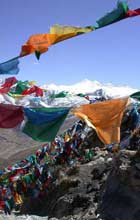 As inspiring as it is to view the treasures of this famous monastery, a visit to Ganden is incomplete without walking its kora , or the pilgrimage around its perimeter. Leading you around the back side of the ridge, thiskora introduces breath-taking views of the river plain thousands of feet beneath as well as of the adjacent, towering, snow-topped mountains thousands of feet above. It is no wonder that chortens (religious towers), prayer flags and prayer stones are sprinkled liberally along this kora in tribute to God and nature. In the late afternoon, we return to Lhasa for a last opportunity to view the structures and enjoy the atmosphere of the Jokhang and Barkhor. (B, L, D)
As inspiring as it is to view the treasures of this famous monastery, a visit to Ganden is incomplete without walking its kora , or the pilgrimage around its perimeter. Leading you around the back side of the ridge, thiskora introduces breath-taking views of the river plain thousands of feet beneath as well as of the adjacent, towering, snow-topped mountains thousands of feet above. It is no wonder that chortens (religious towers), prayer flags and prayer stones are sprinkled liberally along this kora in tribute to God and nature. In the late afternoon, we return to Lhasa for a last opportunity to view the structures and enjoy the atmosphere of the Jokhang and Barkhor. (B, L, D)
Day Six
Today, we leave Lhasa on a morning flight. Since it is customary for a person's metabolic rate to increase with altitude, don't be surprised if you leave Tibet a few pounds lighter than when you arrived!
When To Visit
Lhasa is special any time of the year, however some visitors might think to time their journey here to coincide with either the Tibetan New Year Festival (Feb./Mar.) or the Shoton Festival (late Aug.).
Tibetan New Year takes place in February or March; the exact dates depend on the lunar calendar. It is not particularly cold during this period, the day time temperature rising to about 60°F. At this time, foreign and Chinese tourists are few, whilst many Tibetans come from far afield to auspiciously herald the New Year at Lhasa's temples and monasteries.
The Shoton festival usually takes place in mid to late August, the precise days determined by the lunar calendar. This is also known as the Opera festival, with singing and acrobatics taking place all over town, but most especially in the grounds of the Dalai Lama's Summer Palace, known as the Norbalinka.
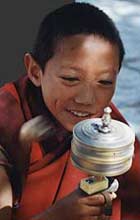 Lhasa is a wondrous place, but customers should be prepared for more basic accommodation than that available in other parts of China. The Lhasa Hotel, the best available, is classed by China's National Tourism Administration as a four star hotel. Depending on your budget and requirements, we can offer various dining options including the services of Imperial Tours' Executive Chef.
Lhasa is a wondrous place, but customers should be prepared for more basic accommodation than that available in other parts of China. The Lhasa Hotel, the best available, is classed by China's National Tourism Administration as a four star hotel. Depending on your budget and requirements, we can offer various dining options including the services of Imperial Tours' Executive Chef.
Imperial Tours does not offer other destinations in Tibet because we do not believe these have facilities appropriate to luxury travelers.
Please note that B, L, D denotes Breakfast, Lunch Dinner.
The above Lhasa tour itinerary is arranged on a private basis only. Visitors interested in a group tour of China, should view our frequent Imperial Tour itinerary.